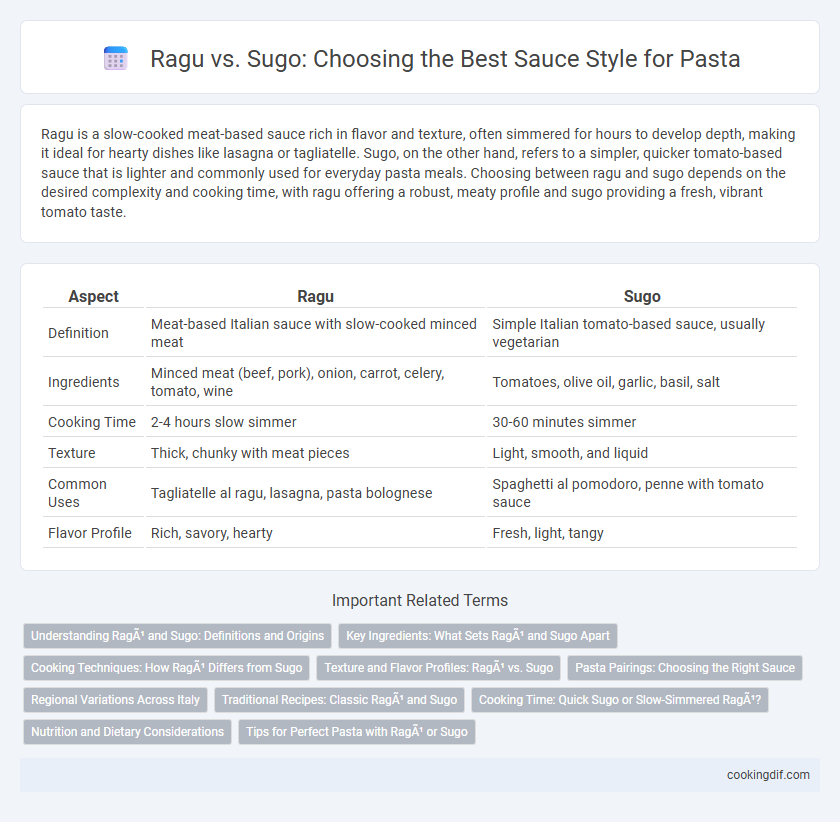Ragu is a slow-cooked meat-based sauce rich in flavor and texture, often simmered for hours to develop depth, making it ideal for hearty dishes like lasagna or tagliatelle. Sugo, on the other hand, refers to a simpler, quicker tomato-based sauce that is lighter and commonly used for everyday pasta meals. Choosing between ragu and sugo depends on the desired complexity and cooking time, with ragu offering a robust, meaty profile and sugo providing a fresh, vibrant tomato taste.
Table of Comparison
| Aspect | Ragu | Sugo |
|---|---|---|
| Definition | Meat-based Italian sauce with slow-cooked minced meat | Simple Italian tomato-based sauce, usually vegetarian |
| Ingredients | Minced meat (beef, pork), onion, carrot, celery, tomato, wine | Tomatoes, olive oil, garlic, basil, salt |
| Cooking Time | 2-4 hours slow simmer | 30-60 minutes simmer |
| Texture | Thick, chunky with meat pieces | Light, smooth, and liquid |
| Common Uses | Tagliatelle al ragu, lasagna, pasta bolognese | Spaghetti al pomodoro, penne with tomato sauce |
| Flavor Profile | Rich, savory, hearty | Fresh, light, tangy |
Understanding Ragù and Sugo: Definitions and Origins
Ragu is a rich, slow-cooked Italian sauce typically made with ground meat, vegetables, and tomatoes, originating from regions like Bologna and Naples. Sugo refers to simpler Italian tomato-based sauces, generally lighter and faster to prepare, often used as a versatile pasta topping. Understanding the regional origins and ingredient composition highlights ragu's hearty complexity versus sugo's straightforward freshness.
Key Ingredients: What Sets Ragù and Sugo Apart
Ragu is characterized by a slow-cooked blend of minced or chopped meats, including beef, pork, or veal, simmered with vegetables like onions, carrots, and celery, along with tomatoes and wine, creating a rich, hearty sauce. Sugo, on the other hand, primarily features a simple tomato base enhanced with garlic, olive oil, and herbs such as basil or oregano, focusing on a lighter, fresher flavor profile. The key distinction lies in ragu's inclusion of meat and longer cooking time versus sugo's minimalist, tomato-forward composition.
Cooking Techniques: How Ragù Differs from Sugo
Ragu involves a slow-cooked process combining finely chopped or ground meat with tomatoes, wine, and aromatic vegetables, resulting in a rich, thick sauce with deep, developed flavors. Sugo is typically a simpler, quicker tomato-based sauce without meat or with minimal additions, emphasizing fresh, bright tomato flavors. The extended simmering time in ragu allows collagen and fats to break down, enhancing texture and complexity compared to the lighter, more straightforward preparation of sugo.
Texture and Flavor Profiles: Ragù vs. Sugo
Ragu features a thick, hearty texture with slow-cooked minced meat and rich tomato base, creating deep, robust flavors that meld savory, umami, and aromatic herbs. Sugo is typically lighter, primarily tomato-based with olive oil, garlic, and fresh basil, offering a fresh, bright, and tangy flavor profile with a smoother, less chunky consistency. The distinct textures influence pairing choices: ragu complements wide pasta shapes absorbing the dense sauce, while sugo suits delicate pastas that highlight its subtle, vibrant essence.
Pasta Pairings: Choosing the Right Sauce
Ragu, a slow-cooked meat-based sauce, pairs best with hearty pasta like pappardelle or tagliatelle, where the sauce's rich texture clings to wide noodles. Sugo, a lighter tomato-based sauce often without meat, complements delicate pasta types such as spaghetti or linguine, allowing the fresh flavors to shine. Selecting the appropriate sauce enhances the pasta experience by balancing texture and flavor intensity.
Regional Variations Across Italy
Ragu and sugo represent distinct sauce styles with strong regional variations across Italy; Ragu, a meat-based sauce slow-cooked with tomatoes and aromatic vegetables, is predominantly associated with Northern regions like Emilia-Romagna and Tuscany, exemplified by Ragu alla Bolognese. Sugo, a simpler, lighter tomato sauce often made with fresh tomatoes, garlic, and olive oil, is common in Southern Italy, including Campania and Sicily, where the emphasis lies on fresh, bright flavors. These regional differences reflect local ingredients and culinary traditions, shaping the unique pasta experiences found throughout Italy.
Traditional Recipes: Classic Ragù and Sugo
Classic ragu is a slow-cooked Italian meat sauce featuring ground beef or pork, tomatoes, onions, carrots, celery, and red wine, traditionally simmered for hours to develop deep, rich flavors. Sugo, on the other hand, is a simpler tomato-based sauce often made with garlic, basil, and olive oil, emphasizing fresh and vibrant tomato taste. Both sauces serve distinct culinary roles in Italian cuisine: ragu pairs typically with thick pasta or lasagna, while sugo complements lighter pasta varieties like spaghetti or penne.
Cooking Time: Quick Sugo or Slow-Simmered Ragù?
Sugo typically requires a short cooking time, often prepared in under 30 minutes, delivering a fresh and vibrant tomato flavor ideal for weeknight meals. Ragu demands slow simmering for at least two hours, allowing meat, vegetables, and wine to meld into a rich and deeply complex sauce. Choosing between sugo and ragu hinges on whether a quick, light sauce or a hearty, slow-cooked flavor is preferred.
Nutrition and Dietary Considerations
Ragu, a slow-cooked meat-based sauce, offers high protein content and essential amino acids, benefiting muscle repair and satiety, while its fat levels vary depending on the meat used. Sugo, typically a lighter tomato-based sauce without meat, provides antioxidants such as lycopene and is lower in calories and fat, making it suitable for vegetarian or low-fat diets. Both sauces can be adapted for dietary restrictions, but ragu may require portion control for saturated fat intake, whereas sugo supports heart-healthy and plant-based eating plans.
Tips for Perfect Pasta with Ragù or Sugo
For perfect pasta with ragu or sugo, simmer ragu slowly to develop rich, deep flavors from meats and vegetables, ensuring a thick, hearty sauce that clings to the pasta. Use high-quality canned tomatoes or fresh, ripe tomatoes for sugo to achieve a bright, fresh taste, cooking it gently to preserve the natural sweetness. Always reserve pasta water to adjust sauce consistency, enhancing emulsification and ensuring the sauce coats each strand or piece perfectly.
Ragù vs sugo for sauce style Infographic

 cookingdif.com
cookingdif.com